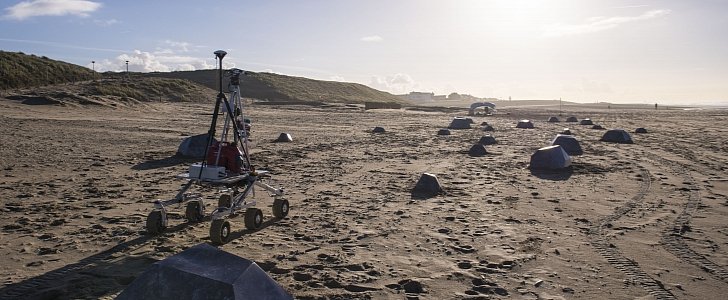The European Space Agency is having none of the Curiosity hype, choosing instead to build its own breed of Mars rovers that will one day explore the surface of the red planet.
Obviously, the only relation between ESA and NASA is one of friendly rivalry and, more often than not, of fruitful cooperation. Curiosity’s success, then, couldn’t have sparked anything other than the ambition to reach the Martian surface with an automated vehicle of its own.
But since Europe lacks the open vastness of places like the Nevada desert, ESA needed to find another suitable place to test its vehicles. It turns out that a beach called Katwijk in Holland offers the kind of conditions the ESA scientists were looking for, even though a few interventions were required.
The great distances between our planet and Mars make direct teleoperation (you know, a fancy astronaut word for “RC”) unfeasible since the lag would be counted in hours. That’s why any vehicle that wants to be able to make it to Mars needs to be able to get around on its own. It needs a large dose of autonomy.
Ha, the auto industry has been working on this for years, and it’s close to solving the problem, so what’s the big deal? Surely the ESA masterminds would have no problem figuring out a way to allow the rover safe passage over the red planet’s scenery, right?
Absolutely, but there’s a catch. Both of the vehicle’s software systems rely on predefined landmarks, something the beach in Holland is in desperate need of. The rover uses images from satellite (or a drone, in this case) that it cross-references with what it sees on the ground, and the other is a basic lidar sensor that also needs objects to bounce its lasers back.
So ESA turned to its engineers to come up with a solution, and they did. The agency in charge of space exploration splattered 212 cardboard “rocks” around the beach to make it easier for the rover to get its bearings.
Obviously, all the rocks have been removed after the testing session was over. The European Space Agency takes littering very seriously.
But since Europe lacks the open vastness of places like the Nevada desert, ESA needed to find another suitable place to test its vehicles. It turns out that a beach called Katwijk in Holland offers the kind of conditions the ESA scientists were looking for, even though a few interventions were required.
The great distances between our planet and Mars make direct teleoperation (you know, a fancy astronaut word for “RC”) unfeasible since the lag would be counted in hours. That’s why any vehicle that wants to be able to make it to Mars needs to be able to get around on its own. It needs a large dose of autonomy.
Ha, the auto industry has been working on this for years, and it’s close to solving the problem, so what’s the big deal? Surely the ESA masterminds would have no problem figuring out a way to allow the rover safe passage over the red planet’s scenery, right?
Absolutely, but there’s a catch. Both of the vehicle’s software systems rely on predefined landmarks, something the beach in Holland is in desperate need of. The rover uses images from satellite (or a drone, in this case) that it cross-references with what it sees on the ground, and the other is a basic lidar sensor that also needs objects to bounce its lasers back.
So ESA turned to its engineers to come up with a solution, and they did. The agency in charge of space exploration splattered 212 cardboard “rocks” around the beach to make it easier for the rover to get its bearings.
Obviously, all the rocks have been removed after the testing session was over. The European Space Agency takes littering very seriously.



